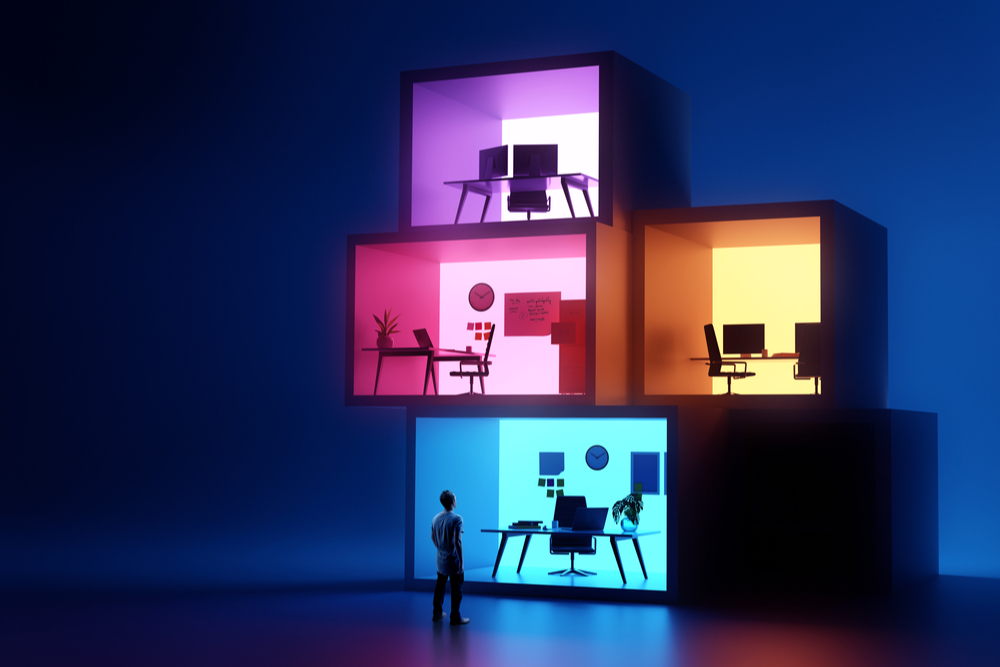We have all had to cope with the changes caused by COVID-19, no? Last spring and summer we were talking about “return to work” and “hybrid working”. Now the conversation is shifting to hot desking. It is time we talked about this. What hot desking challenges will we face and how can we manage them? One significant challenge of hot desking is maintaining a sense of personal space and organization in a constantly changing environment. Employees may feel disconnected or less comfortable without a dedicated workstation to call their own.
To manage this, an office design company can implement creative solutions such as providing ample personal storage lockers and creating designated quiet zones and collaborative areas. By thoughtfully designing the workspace to include flexible, multifunctional furniture and clear organizational systems, businesses can ensure that employees still have spaces that feel personal and conducive to productivity, even without permanent desks.
Hot Desking Defined
First, what is hot desking? Here is a nice article that talks about hot desking, hoteling (remember that term?) and flexible working. (Bonus factoid: SpaceIQ recruited me to run product management some years back. I turned them down. You decide if that was brilliant or foolish.) The short-answer definition is this:
- Hot desking means you come to work, grab any available desk/cube/office/space, and work there for the day.
- Hoteling is hot desking, but you have a way to reserve a space in advance.
- Flexible work is a more general term encompassing flexibility in where and when you work. In other words, what we are living with these days.
My take is that some organizations are moving beyond just getting people back in the office, for however long. They are beginning to consider office redesigns that incorporate a hybrid work environment. Meaning, there will no longer be a space in the office for every worker, every day. Thoughtful people (that is you, dear reader) want to anticipate the hot desking challenges that will arise and have solutions at the ready.
Hot Desking Challenges, Some Quaint and Some Real
As I researched the hot desking topic, I came across this Forbes article, describing hot desking as a horrible idea. It turns out to have been published in late 2019. Hmm, did anything happen in 2020 that might have changed the circumstances around hot desking?
I could look at this article as one of those “that didn’t age well” Internet things. Or I could hold up the article as evidence of how much our world has changed in the last two years. I will skip past the quaint hot desking challenges (read the article and tell me what you think) and focus on some hoteling and hot desking challenges that you will want to consider.
You Cannot Find Key People
Here is one hot desking challenge the Forbes article raises: If you cannot predict where you and others are working in the office today, how can you know where to find key people you want to reach?
Answer: the pandemic has taught us that we can rely on other things besides physical proximity to find people. Slack, Teams, and other collaboration tools allow us to chat with our coworkers wherever they are. These collaboration tools also make it easy to move from chat to a voice call to a video call.
Hot Desking Interrupts On-the-Job Training
Got screen sharing? On-the-job training got a lot more virtual starting in 2020. The idea hinted at in the Forbes article that we must be physically next to each other to conduct training is so… 2019.
It is Hard to Get Help
I guess Forbes is worried that with hot desking you will not be able to station yourself on the path to the washroom that IT Support takes each day. You will not be able to collar someone and say, “Hey, could you have a look at this?” That is certainly true.
Equally true: IT Support already has a process to request help. Submit a ticket. Call someone. Start a chat. This hot desking challenge already has a solution, even if not everyone in the organization wants to use it.
We Cannot Have “Super-Quick” Meetings
I love this hot desking challenge. Why do I think this translates as, “If you and I are not in the office together, how can I (as your boss) stop by your office and interrupt what you are doing so we can have a Super-Quick meeting where I ask you to do something right away?” (Cue your favorite Office Space meme here).
Again, collaboration tools address this hot desking challenge. Hit me up via chat. Or phone. Or video. You might also notice that I have set my status to Focus Time, meaning I would rather not be interrupted to get you that report right away.
Then again, maybe Super-Quick meetings (as I have described them) are part of the culture of your organization. If so, remember that technology rarely solves cultural challenges.
Other Hoteling and Hot Desking Challenges
There are other hoteling and hot desking challenges that are more of the implementation variety. How can I get this done? First up: reservations.
How Will Users Reserve a Workspace?
Are you looking to offer users a chance to reserve a workspace before they show up at the front door? Maybe you want to use a reservation system to control how many users are in the office at one time (no workspaces open means the user works from home today).
There are reservation systems out there. Robin, Envoy, Condeco, Skedda. Here is a comparison article you might find helpful.
Alternatively, you might extend your Exchange system to include workspaces. You can already set up “resource accounts” for things like conference rooms or drivers (this from the NGO world). The next stop would be to define workspaces as other resource accounts.
All this matters because you want to address this question: One room reservation app? Or two?
Will You Have a Standard Workspace Build?
You are familiar with a standard computer image. You want a Windows machine? This is what you get. Want a Macintosh? Here is our supported configuration. Will you extend that idea to workspaces?
- What type of chair?
- What type of monitor? And how many?
- Stand-up desk?
- Docking station?
- Ethernet jack and cable?
- Desk phone? (And can I reprogram it to reflect my office extension?)
- Any plants?
If you have a standard workspace build, the desire to reserve a specific workspace will be reduced. And if you do not have a standard workspace build…be prepared for users asking to reserve a particular space.
Think About Ergonomics
Whether you have a standard workspace build or not, ergonomics will be a hot desking challenge. I will need to know how to adjust the chair height for whatever chair is in the workspace. I might want to adjust the monitor as well.
Dude, Where is My Printer?
I have witnessed user account setups that included configurations for just the printers near the user’s workspace. This made sense. Why program in all the printers in the office if I’m going to use these two 99% of the time?
Ah, but the hot desking challenge here is that IT does not know where in the office you will be working. Be prepared to handle the extra printer configurations. And be ready with a solution that tells users how to find the printer they are using.
The Biggest Hot Desking Challenge
The biggest hot desking challenge you may face is this: convincing users to give up their offices. I have worked in organizations where office furniture was allocated according to your position in the hierarchy. I saw some epic office space battles.
If you are implementing hot desking as part of a floor plan redesign, then the question of who has an office may be a fait accompli. If you need to convince users that moving to a hot desking or hoteling arrangement is a good idea… then prepare to do some selling.
Where to from Here?
Two years ago, I could not understand the benefit of tapping your credit or debit card to make a payment. Now, I give thanks for every time I can do this and avoid one more round of hand sanitizing. We are all on new ground as we reconsider how work will get done in and out of the office. At least we have each other to count on!





0 Comments